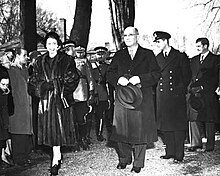Monarchy in New Brunswick
[5]The role of the Crown is both legal and practical; it functions in New Brunswick in the same way it does in all of Canada's other provinces, being the centre of a constitutional construct in which the institutions of government acting under the sovereign's authority share the power of the whole.
[7] The Canadian monarch—since 8 September 2022, King Charles III—is represented and his duties carried out by the lieutenant governor of New Brunswick, whose direct participation in governance is limited by the conventional stipulations of constitutional monarchy, with most related powers entrusted for exercise by the elected parliamentarians, the ministers of the Crown generally drawn from among them, and the judges and justices of the peace.
[9][10] This arrangement began with the 1867 British North America Act[1] and continued an unbroken line of monarchical government extending back to the early 16th century.
Gifts are also sometimes offered from the people of New Brunswick to the royal person to mark a visit or an important milestone; for instance, Queen Elizabeth II was given in 1951 a pair of hand-woven car blankets made by the loom crofters of Gagetown and,[14] in 1976, a quilt hand-sewn by the Havelock United Baptist Church Ladies' Auxiliary.
Though he resided in Halifax, the Prince acted as commander-in-chief of both Nova Scotia and New Brunswick[20] and travelled throughout, visiting Fredericton and Saint John (including Fort Howe), along the way meeting with the colony's inhabitants and first lieutenant governor, Colonel Thomas Carleton.
[33] Elizabeth made her first tour of New Brunswick as queen in 1959, arriving at Fredericton airport on 29 July; she and the Duke of Edinburgh (who, by then, also held the title of prince) were welcomed by Lieutenant Governor Joseph Leonard O'Brien and a 100-man guard of honour assembled by The Black Watch (Royal Highland Regiment) of Canada.
Lieutenant Governor Hédard Robichaud (the first Acadian to act as the Queen's representative in New Brunswick) was there for the royal couple's arrival, after which they visited the Legislative Building and City Hall.
At the parliament, Chief Anthony Francis, President of the Union of New Brunswick Indians, presented a petition to the Queen,[36] demonstrating the connection between the Canadian Crown and the Indigenous peoples of Canada.
Elizabeth and Philip stopped at the Boy Scout and Girl Guide jamboree at Woolastook Provincial Park, where they had a picnic with the approximately 3,500 scouts and guides in attendance and watched performances by the Madawaska Dancers,[37] Les jeunes chanteurs d’Acadie, the Kiwanis Steel Band, and the St. Andrew's Pipe Band,[37] before moving on to Kings Landing Historical Settlement,[38][39] there opening Morehouse House and launching the reproduction of the historical sailing ship, Brunswick Lion,[40] which greatly interested Prince Philip, given his naval background.
[38] In Miramichi, the following day, the Queen and Duke watched an armed forces program at CFB Chatham and attended a lunch put on by the provincial Crown-in-Council.
[38] There, Premier Richard B. Hatfield presented Elizabeth with a gift from New Brunswickers: a quilt hand-sewn by the Havelock United Baptist Church Ladies’ Auxiliary.
[45] The royal couple visited St. Joseph's Parish Church in Shediac to unveil a plaque marking the parish's 100th anniversary,[46] The next day, Elizabeth and Philip attended service at Christ Church Cathedral in Fredericton[47] and were at the Legislative Building,[48] where the Queen issued a royal warrant augmenting the province's coat of arms with its present crest, supporters, compartment, and motto.
[59] The royal couple then moved on to watch an equestrian demonstration and meet with 4-H members and the public,[60] including war brides,[61] at Princess Louise Park.




